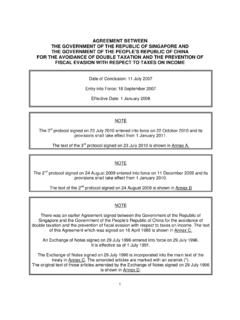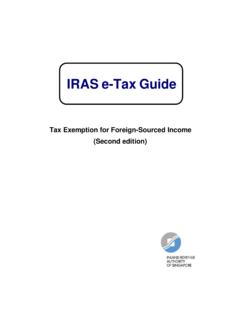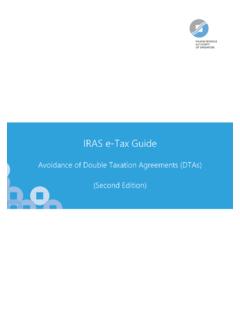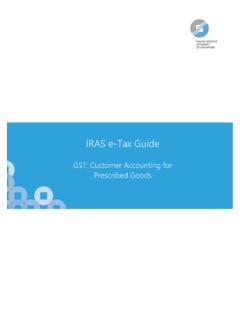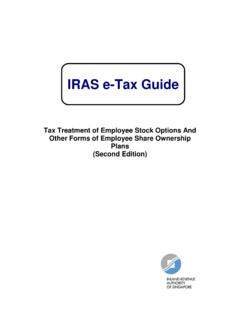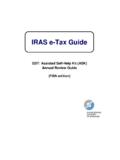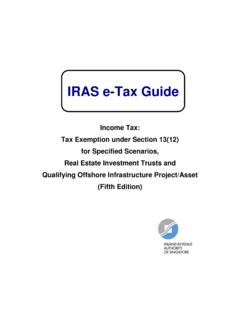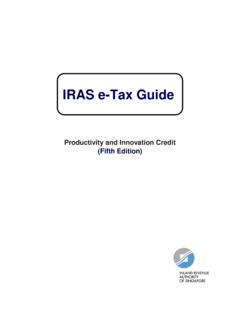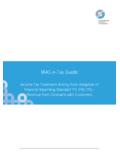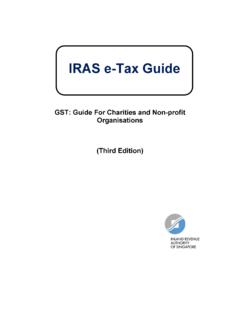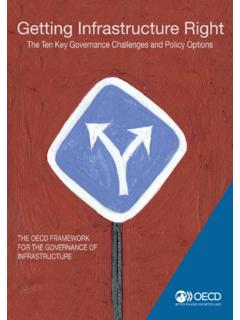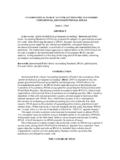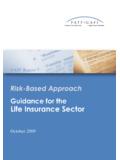Transcription of Table of Contents - IRAS
1 1 IRAS FAQs on the common reporting Standard (First published on 7 December 2016) Table of Contents A) GENERAL .. 2 B) FINANCIAL INSTITUTIONS .. 3 C) FINANCIAL ACCOUNTS .. 7 D) REPORTABLE ACCOUNTS .. 14 E) DUE DILIGENCE 17 F) reporting OBLIGATIONS .. 30 G) REGISTRATION REQUIREMENTS .. 34 H) DATA TRANSMISSION AND SAFEGUARDS .. 35 APPENDIX UPDATES TO IRAS FAQ ON THE common reporting STANDARD .. 36 2 A) GENERAL Wider Approach The CRS set out in the Schedule to the Income Tax (International Tax Compliance Agreements) ( common reporting Standard) Regulations 2016 ( The Schedule ) contains some differences to the CRS set out in OECD s Standard for Automatic Exchange of Financial Account Information in Tax Matters ( AEOI Standard ).
2 Why is there a deviation between The Schedule and OECD s CRS? Singapore s CRS legislation requires and empowers all reporting SGFIs to put in place the necessary procedures and systems to establish the tax residence(s) of all their Account Holders, instead of only for Account Holders that are tax residents of jurisdictions with which Singapore has a Competent Authority Agreement ( CAA ) to exchange financial account information. This is known as the Wider Approach . This approach is cost efficient for the industry since reporting SGFIs would not need to repeatedly review the same accounts to re-establish whether the accounts are reportable each time Singapore enters into a new CAA.
3 reporting SGFIs will only need to transmit to IRAS the information relating to tax residents of Singapore s CAA partners, for IRAS to implement AEOI under the CRS. Accordingly, the CRS as set out in The Schedule is based on Annex 5 of OECD s AEOI Standard, which is modified to provide for the implementation of the Wider Approach. Updated on: 15 Feb 2017 Reliance on the Commentaries on the CRS, CRS Implementation Handbook, and CRS-related FAQs Are reporting SGFIs expected to rely on the OECD s Commentaries in OECD s AEOI Standard, the Standard for Automatic Exchange of Financial Account Information in Tax Matters Implementation Handbook ( CRS Implementation Handbook ), and OECD s CRS-related FAQs for guidance in implementing the CRS?
4 Yes. Given that the CRS as set out in the First Schedule is part of the Income Tax (International Tax Compliance Agreements)( common reporting Standard) Regulations 2016 ( CRS Regulations ) and is the international AEOI Standard 3 developed by the OECD, the OECD s Commentaries ( the Commentary ) on the CRS, the CRS Implementation Handbook, and OECD s CRS-related FAQs are integral to Singapore s CRS implementation. reporting SGFIs are expected to rely closely on these materials for interpretative guidance on the due-diligence and reporting requirements of the CRS, unless they are inconsistent with Singapore s implementation of the Wider Approach.
5 Updated on: 23 Dec 2016 B) FINANCIAL INSTITUTIONS When is a trust that is a Financial Institution considered to be resident in a Participating Jurisdiction? In general, a Financial Institution is resident in a Participating Jurisdiction if it is a resident for tax purposes in the jurisdiction. In the case of a trust that is a Financial Institution (irrespective of whether it is resident for tax purposes in a Participating Jurisdiction), the trust is considered to be a resident in a Participating Jurisdiction if one or more of its trustees are tax resident in such Participating Jurisdiction except if the trust reports all the information required to be reported to another Participating Jurisdiction because it is resident for tax purposes in such other Participating Jurisdiction.
6 Please refer to the Commentary on Section VIII, paragraph 4 for more details. When is a trustee considered to be resident in Singapore? A trustee is resident in Singapore if the trustee is a tax resident of Singapore. A trustee s tax residence is determined based on the trustee s capacity as an individual (quantitative or qualitative presence test) or a company (control and management test): An individual would generally be a tax resident of Singapore if the individual is physically present or exercises an employment in Singapore for at least 183 days in a calendar year A company would generally be a tax resident of Singapore if the control and management of its business is exercised in Singapore.
7 How is the residency of a fiscally transparent Financial Institution (other than a trust) to be determined? Where a Financial Institution (other than a trust) is fiscally transparent, it is a Participating Jurisdiction Financial Institution if: a) it is incorporated under the laws of the Participating Jurisdiction; b) it has its place of management in the Participating Jurisdiction; or 4 c) it is subject to financial supervision in the Participating Jurisdiction. Please refer to the Commentary on Section VIII, paragraph 4 for more details.
8 Under subparagraph A(6)(b) of Section VIII of the CRS, the term Investment Entity includes any entity, the gross income of which is primarily attributable to investing, reinvesting, or trading in financial assets, if the entity is managed by another entity that is a Financial Institution under the CRS. When is an entity considered to be managed by another entity? An entity is managed by another entity if the latter entity performs one or more of the following activities or operations (as described in subparagraph A(6)(a)(i) to A(6)(a)(iii) of Section VIII of the CRS) on behalf of the first mentioned entity: a) trading in money market instruments; foreign exchange; exchange, interest rate and index instruments; transferable securities; or commodity futures trading; b) individual and collective portfolio management.
9 Or c) otherwise investing, administering, or managing Financial Assets or money on behalf of other persons. However, an entity does not manage another entity if it does not have the discretionary authority to manage the latter entity s assets (in whole or part). Please refer to the Commentary on Section VIII, paragraph 17 for more details. Reserved Investment Power Trusts Would a reserved investment power trust, where investment powers over the trust s assets are reserved solely to an individual who is not the trustee, be considered to be an Investment Entity as defined under paragraph A(6)(b) of Section VIII of the CRS?
10 This depends on whether the managed by criterion under subparagraph A(6)(b) of Section VIII of the CRS is met. For example, if the trustee which is a Financial Institution performs, either directly or through a service provider, any of the activities or operations described in subparagraph (A)(6)(a) of Section VIII of the CRS on behalf of the managed trust, and has discretionary authority to manage the trust s assets (in whole or in part), such a trust could be considered to be an Investment Entity.
